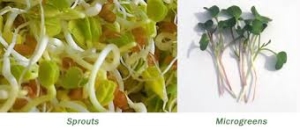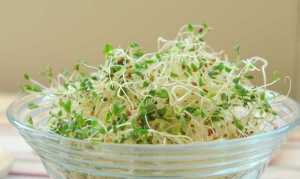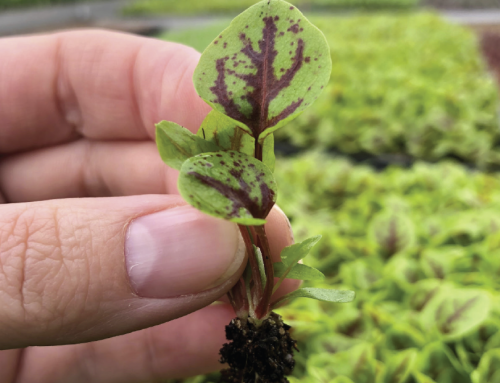 Question:
Question:
Sprouts and Microgreens are:
a.) Basically the same thing
b.) Sort of the same thing
c.) Two totally different things
d.) The preferred diet of the Asiatic Water Buffalo
Answer:
c.) Two totally different things
Congratulations if you got it right! Sprouts and microgreens, while often referred to as one and the same, are in fact quite different.
 Sprouts, when you get right down to it, are just germinated seeds. Harvested before their secondary leaves emerge, they are generally smaller than microgreens. And where microgreens are grown in soil, sprouts are grown in water. After a thorough rinsing, seeds are soaked anywhere from 20 minutes to 12 hours, depending on the type. The seeds are then placed in ‘spouting vessels’ and left at room temperature, where they grow quickly, even without sunlight. To prevent bacterial build-up, the sprouts are rinsed two to four times a day. After three to five days, they are ready for consumption. Alfalfa, amaranth, barley, broccoli, lentils, mung beans, pea shoots, radish, sunflower, and clover are some common examples of sprouts.
Sprouts, when you get right down to it, are just germinated seeds. Harvested before their secondary leaves emerge, they are generally smaller than microgreens. And where microgreens are grown in soil, sprouts are grown in water. After a thorough rinsing, seeds are soaked anywhere from 20 minutes to 12 hours, depending on the type. The seeds are then placed in ‘spouting vessels’ and left at room temperature, where they grow quickly, even without sunlight. To prevent bacterial build-up, the sprouts are rinsed two to four times a day. After three to five days, they are ready for consumption. Alfalfa, amaranth, barley, broccoli, lentils, mung beans, pea shoots, radish, sunflower, and clover are some common examples of sprouts.
 Microgreens, on the other hand, are tiny plants. Grown in soil or peat moss, they’re harvested after 1 to 3 weeks. The edible portion includes leaves and stems in the cotyledon growth stage (the stage when the first two to four leaves appear). Microgreens tend to have much stronger, more developed flavors, and are generally more nutrient-rich, thanks to being grown in soil. Arugula, tatsoi, kale, beets, radishes, cilantro, basil, parsley, and celery are some examples of microgreens. A recent 2014 USDA study concluded that microgreens contain considerably higher levels of vitamins and carotenoids—about five times greater—than their mature counterparts.
Microgreens, on the other hand, are tiny plants. Grown in soil or peat moss, they’re harvested after 1 to 3 weeks. The edible portion includes leaves and stems in the cotyledon growth stage (the stage when the first two to four leaves appear). Microgreens tend to have much stronger, more developed flavors, and are generally more nutrient-rich, thanks to being grown in soil. Arugula, tatsoi, kale, beets, radishes, cilantro, basil, parsley, and celery are some examples of microgreens. A recent 2014 USDA study concluded that microgreens contain considerably higher levels of vitamins and carotenoids—about five times greater—than their mature counterparts.
So now you know!


